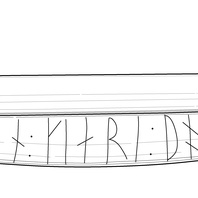
Viking Designs
Drawing of the Thorfast Comb Case
A bone comb case with a runic inscription which reads ‘Thorfast made a good comb’. It is unknown whether the runes were inscribed by Thorfast himself as advertising, or whether the owner inscribed them to remind them where to go for another good comb if they needed one.
Read More
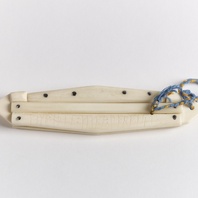
Viking Objects
Reproduction Bone Comb with Runic Inscription
A bone comb with a case with a runic inscription on it. The inscription reads, in translation, “Thorfast made a good comb.” The Vikings had a reputation for looking after their personal hygiene. Combs were an important part of that process, not just for combing your hair but also for removing nits and lice.
Read More
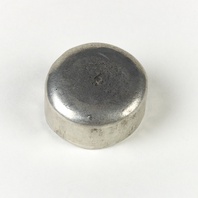
Viking Objects
Reproduction Round Weight
A round lead weight made in an open mould, as shown by the rounded edges of the top which indicate shrinkage in the mould.
Read More
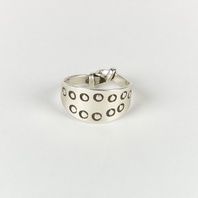
Viking Objects
Reproduction Stamped Finger Ring
A reproduction, stamped, silver ring with knotted ends. Rings with this type of stamped decoration are typical of Scandinavian design during the Viking Age.
Read More
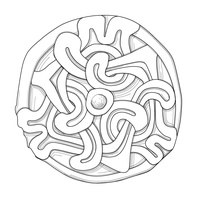
Viking Designs
Drawing of Copper Alloy Disc Brooch
Drawing of a copper alloy, gilded brooch with a zoomorphic design. Brooches were a typical part of female dress. Scandinavian brooches came in a variety of sizes and shapes which included disc, trefoil, lozenge, equal-armed, and oval shapes. The different brooch types served a variety of functions in Scandinavian female dress with oval brooches typically being used as shoulder clasps for apron-type dresses and the rest being used to secure an outer garment to an inner shift. Anglo-Saxon brooches do not match this diversity of form with large disc brooches being typical of ninth century dress styles with smaller ones becoming more popular in the later ninth and tenth centuries. However, since disc brooches were used by both Anglo-Saxon and Scandinavian women they are distinguished by their morphology. Scandinavian brooches were typically domed with a hollow back while Anglo-Saxon brooches were usually flat. Moreover, Anglo-Saxon brooches were worn singly without accompanying accessories.
Read More
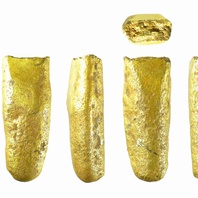
Viking Objects
Gold Ingot (BH-720251)
The Vikings arriving in England had a bullion economy in which they paid for goods, most commonly, with silver that was weighed to an amount agreed between the buyer and the seller. Though rarer than silver equivalents, this gold ingot formed part of the bullion currency used by Vikings in England. It took some time for the Scandinavian settlers to adopt a monetary economy like that of the Anglo-Saxons, and both systems were used simultaneously for a while before they fully adopted the new system. The Vikings were familiar with monetary economies but they treated coins as just another form of bullion before adoption of a monetary economy.
Read More
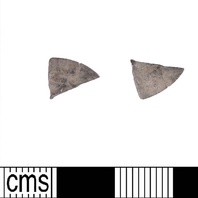
Viking Objects
Arabic Dirham Fragment (LIN-5F318A)
Fragment of an Early Medieval Arabic dirham, probably dating between the eighth-ninth centuries. The fragment appears to have been cut down into a smaller module. The fact that it may have been cut suggests that it was used as part of a bullion transaction in line with the dual bullion-monetary economy established by the Vikings in England. The circulation of Arabic dirhams is generally attributed to Viking activities and this example’s proximity to the winter camp of Torksey likely connects the dirham with the activities of its inhabitants. Arabic coins are especially useful for dating sites, because they carry the date when they were minted. This permits precise dating where the part of the coin with the date survives, whereas European coins can only be dated to the reign of the ruler depicted on them. In western descriptions of these coins, the Arabic dates found on the coins are usually listed in square brackets, as above, and the European equivalent is listed after it. This coin is a product of the Abbasid Caliphate which was ruled from its capital in Baghdad. The Abbasid Caliphate was at its greatest extent c.850 CE, occupying lands from Morocco in the west to Afghanistan in the east.
Read More
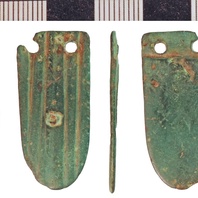
Viking Objects
Copper-Alloy Strap-End (NLM-B633CE)
The decoration on this cast copper-alloy strap-end involves a series of deep longitudinal grooves which may actually represent previous damage. If decorative, the object is similar to Thomas Class E Type 3 strap ends whose distribution generally falls in the eastern Danelaw and around the Irish Sea. Strap ends came in various styles and were fairly common throughout the Viking world. They were used to decorate the ends of belts and to stop them getting damaged.
Read More
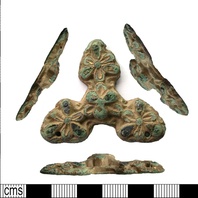
Viking Objects
Carolingian Trefoil Mount (LEIC-C5F14A)
This Carolingian trefoil mount has holes drilled through it for affixing to a surface, possibly a book. It is likely to have been brought from the European continent by Viking raiders or traders.
Read More
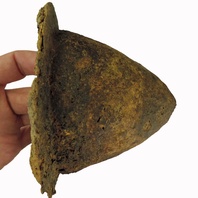
Viking Objects
Shield Boss (1989-59/9013)
This is a probable Viking shield boss from Repton, Derbyshire. This shield boss is possible evidence for the Viking Great Army’s overwintering at Repton in 873. The typical construction of a ‘Viking’ shield at the time involved several wooden planks glued together and cut into a circle. The face of the shield was then covered in linen or rawhide with rawhide edging that was either tacked or sewn on. Finally, a metal boss would be attached along with the handle over a hole in the centre. The purpose of the metal boss was to protect the user’s hand in combat.
Read More
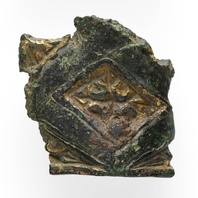
Viking Objects
Broken Gilt Vessel (CM.1822.2008)
A broken gilt vessel fragment decorated with a Carolingian motif within a repeated diamond pattern. A single iron rivet provides evidence that this vessel might have been repaired and reused. The vessel will have been brought from Francia to Torksey, Lincolnshire, where it was found, perhaps by a member of the Great Heathen Army or its train.
